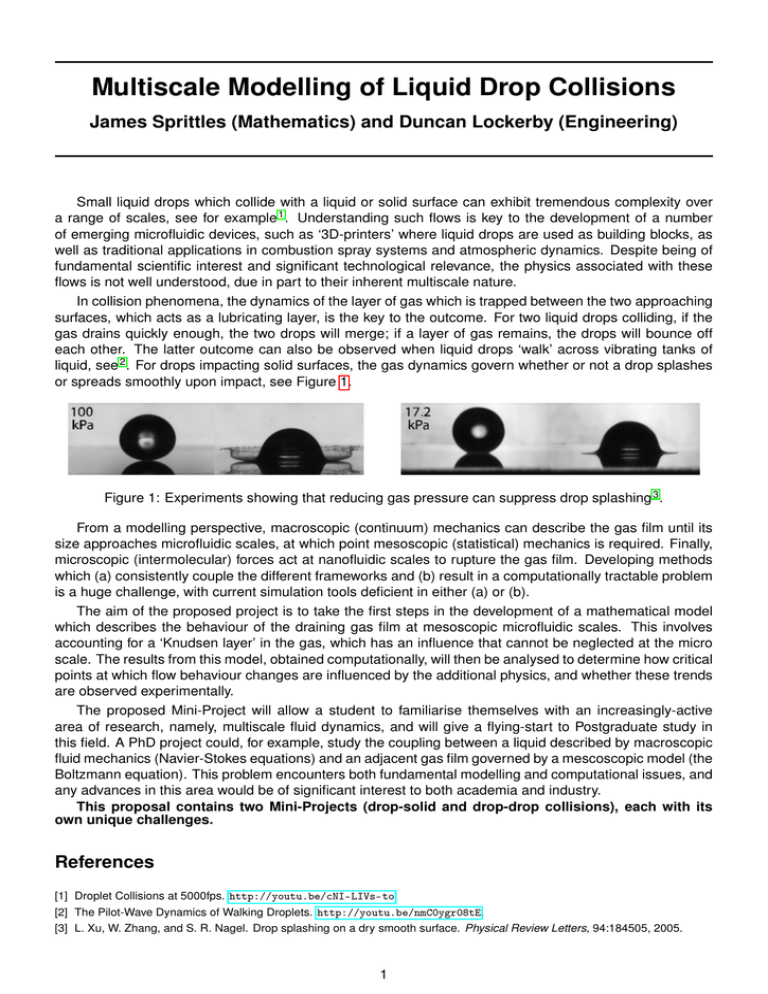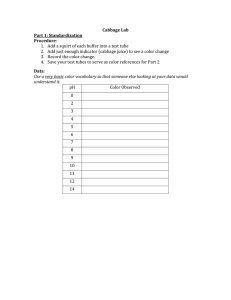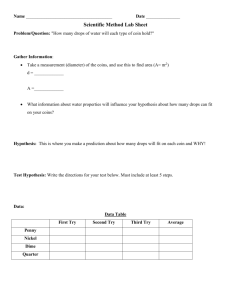Multiscale Modelling of Liquid Drop Collisions
advertisement

Multiscale Modelling of Liquid Drop Collisions James Sprittles (Mathematics) and Duncan Lockerby (Engineering) Small liquid drops which collide with a liquid or solid surface can exhibit tremendous complexity over a range of scales, see for example 1 . Understanding such flows is key to the development of a number of emerging microfluidic devices, such as ‘3D-printers’ where liquid drops are used as building blocks, as well as traditional applications in combustion spray systems and atmospheric dynamics. Despite being of fundamental scientific interest and significant technological relevance, the physics associated with these flows is not well understood, due in part to their inherent multiscale nature. In collision phenomena, the dynamics of the layer of gas which is trapped between the two approaching surfaces, which acts as a lubricating layer, is the key to the outcome. For two liquid drops colliding, if the gas drains quickly enough, the two drops will merge; if a layer of gas remains, the drops will bounce off each other. The latter outcome can also be observed when liquid drops ‘walk’ across vibrating tanks of liquid, see 2 . For drops impacting solid surfaces, the gas dynamics govern whether or not a drop splashes or spreads smoothly upon impact, see Figure 1. Figure 1: Experiments showing that reducing gas pressure can suppress drop splashing 3 . From a modelling perspective, macroscopic (continuum) mechanics can describe the gas film until its size approaches microfluidic scales, at which point mesoscopic (statistical) mechanics is required. Finally, microscopic (intermolecular) forces act at nanofluidic scales to rupture the gas film. Developing methods which (a) consistently couple the different frameworks and (b) result in a computationally tractable problem is a huge challenge, with current simulation tools deficient in either (a) or (b). The aim of the proposed project is to take the first steps in the development of a mathematical model which describes the behaviour of the draining gas film at mesoscopic microfluidic scales. This involves accounting for a ‘Knudsen layer’ in the gas, which has an influence that cannot be neglected at the micro scale. The results from this model, obtained computationally, will then be analysed to determine how critical points at which flow behaviour changes are influenced by the additional physics, and whether these trends are observed experimentally. The proposed Mini-Project will allow a student to familiarise themselves with an increasingly-active area of research, namely, multiscale fluid dynamics, and will give a flying-start to Postgraduate study in this field. A PhD project could, for example, study the coupling between a liquid described by macroscopic fluid mechanics (Navier-Stokes equations) and an adjacent gas film governed by a mescoscopic model (the Boltzmann equation). This problem encounters both fundamental modelling and computational issues, and any advances in this area would be of significant interest to both academia and industry. This proposal contains two Mini-Projects (drop-solid and drop-drop collisions), each with its own unique challenges. References [1] Droplet Collisions at 5000fps. http://youtu.be/cNI-LIVs-to. [2] The Pilot-Wave Dynamics of Walking Droplets. http://youtu.be/nmC0ygr08tE. [3] L. Xu, W. Zhang, and S. R. Nagel. Drop splashing on a dry smooth surface. Physical Review Letters, 94:184505, 2005. 1



